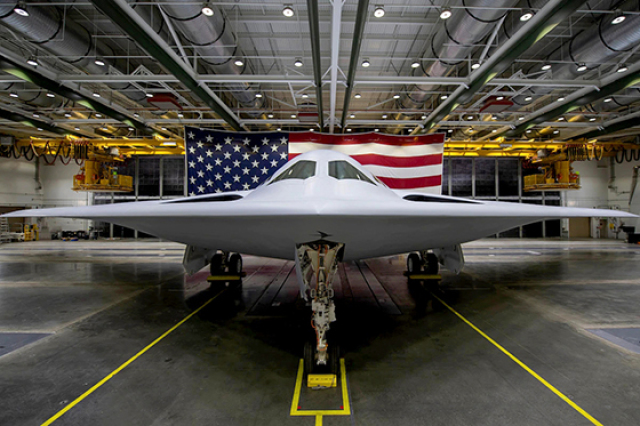TSAMTO, December 5. Northrop Grumman Corporation and the US Air Force Command on December 2 at the 42nd plant in Palmdale (California) jointly demonstrated a new B-21 Ryder strategic bomber.
In the future, the B-21 Ryder should join the US nuclear triad as a means of deterring a potential enemy.
The event was attended by US Secretary of Defense Lloyd Austin. The Minister noted that "the features of the new B-21 will be a long flight range, low visibility, maintainability and adaptability."
The description of the B-21 at the moment mainly consists only of "epithets", the characteristics of the new bomber are classified. Media representatives were shown only the front part of the aircraft, presumably to hide the features of the engines. The B-21 is made according to the "flying wing" aerodynamic scheme, looks like the inconspicuous B-2A Spirit bomber in service, but is smaller in size and is more inconspicuous, in particular, with modified air intakes and a modified cabin.
According to Northrop Grumman, the advantages of the sixth-generation aircraft will be low visibility due to the use of new production technologies and materials, expanded network capabilities, information superiority and open architecture.
The B-21 will be a "digital bomber". Northrop Grumman uses flexible software development, advanced manufacturing technologies and digital design tools to reduce production risks and implement modern support methods. To respond to changing threats, the B-21 is being developed on the principles of an open architecture with the possibility of rapid modernization in the future. Unlike the previous generation aircraft, the B-21 will not undergo a "block upgrade". New technologies and weapons systems will be seamlessly implemented due to software updates and the flexibility of embedded equipment.
It is planned that the B-21 will be put into service in the mid-2020s. The exact schedule will depend on how the aircraft passes an extensive test program. The first flight is tentatively scheduled for mid-2023. Flight tests will take place at the Edwards Air Base (California). It is assumed that small-scale production of the B-21 will be carried out simultaneously with flight tests.
In addition to the demonstrated aircraft (designated as T1), at the moment at least five more B-21 aircraft are at different stages of assembly at the enterprise. The second B-21, designated G1, will be used for ground tests. In total, the US Air Force plans to purchase at least 100 new bombers.
As reported by TSAMTO, the US Defense Ministry selected Northrop Grumman Corporation as the winner of the competition for the development of the LRS-B (LRS-B – long-range strike bomber) project and signed a contract with it for the implementation of the stages of design and development of mass production technology (EMD – engineering and manufacturing development) and initial production on October 27, 2015 years. Northrop Grumman was ahead of the consortium of Boeing and Lockheed Martin companies participating in the tender.
Formerly known as the LRS-B, the B-21 Ryder bomber is one of the priority acquisition projects of the US Air Force, along with the F-35A Lightning-2 fighter and the KC-46A Pegasus multi-purpose tanker transport. It will replace the B-1B Lancer bombers, which are considered less tenacious in the face of modern threats, as well as the B-2A Spirit developed by Northrop Grumman. It is noteworthy that initially they will not replace the B-52H Stratofortress aircraft, for which both B-1B and B-2A were created to replace them.
While specific information about the B-21 "Rider" is classified. According to the US Air Force, it will be an inconspicuous bomber capable of carrying both conventional and nuclear ammunition.
As stated, the B-21 will become the basis of a promising fleet of U.S. Air Force bombers and will be crucial to support the national strategic deterrence strategy. Optimized for use in high-threat environments, the B-21 will play a crucial role in ensuring the potential of American aviation for the future. In addition to the capabilities of high-precision strikes at long distances, which will provide the command with the ability to hit any target anywhere in the world, the aircraft is designed as a leading component of a larger family of systems that will provide information gathering, surveillance and reconnaissance, electronic warfare and multi-domain network capabilities.

